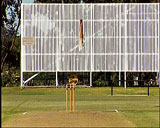The science of reading
Nagraj Gollapudi speaks to Sean Müller about the art of predicting bowlers
|
|

|
Sean Müller took a PhD in Human Movement Studies from the University of Queensland in 2005 in an attempt to answer precisely that question. Müller, now a lecturer in Motor Learning and Control at the Royal Melbourne Institute of Technology University, came to the conclusion that top-class batsmen have the ability to read the ball much earlier than players at a lower level. World-class batsmen, he found, also predicted more accurately than other cricketers which way the ball would swing even before the ball left the bowler's hands, and where it would bounce well before it was in flight.
Time is critical in picking up the line. At international level, when a fast bowler is bowling, it takes about 600 milliseconds for the ball to reach the batsman from the point of release, and approximately 900ms for a spinner. The total time the batsman takes to make his movements is much greater. The visual processing of the information takes about 200ms, the movement of the feet about 350-400ms, the back-lift about 200ms, and the downswing another 200ms. "So, you can't wait till late in the ball's flight or bounce to start making your decision," says Müller.
His research involved putting to test a few Australian Test batsmen, in addition to domestic and club players. One of the tests was video-based, where the batsman was shown a clip of a bowler running in. The video was frozen at various stages of the run-up and delivery, after which the batsman was asked to make predictions about the delivery's length and type based on the visual information he had received till then. "We also occluded the body of the bowler, so you'd see this little hand running in all the way from the start. And then the screen would go black at the point of the ball's release," says Müller.
Another test was conducted in an actual cricket environment, where a batsman wearing a pair of liquid-crystal spectacles faced a bowler. The batsman's vision was blocked just before the point of the ball's release so as to understand if he had gleaned any information about the delivery before the ball was in flight. Or the batsman's vision would be blocked just before the ball had bounced, to find out if he could use information gathered in early flight.
Müller says that most batsmen can't verbally explain where the information is coming from. They just tend to be able to predict where the ball is going when they are shown videos, which means the information is received on a subconscious level. "It comes through numerous hours of practice, exposure to different environments, facing different bowlers, facing the same bowler many times," he explains.
Müller's research has the potential of allowing coaches to understand which parts of the body information is picked up from to predict the length and the type of ball that will be bowled. And that, he thinks, will benefit coaches and help them understand and identify talent, as well as help batsmen understand how bowlers operate.
Only a fraction of Cricinfo Magazine content is available on cricinfo.com. Cricinfo Magazine is now available as a digital download that is an exact replica of the print edition. Click here for a sample, and here for a special introductory deal.
Nagraj Gollapudi is Assistant Editor of Cricinfo Magazine